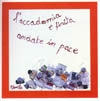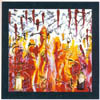  
  
  
  
  
  
  
  
  
|
HOW SHE
PLAYS
Patrizia Minelli is at the decisive
age that signals the generational passage, in art, from
the experimentation's and the philological meditations to
the act. But what to do?
A work that renounces the critical transcendence, an
ironical game that transforms the utopia into work. Is
there salvation - we ask ourselves - for the painted
surface?
 With much effort, running from
office to school, Patrizia attended the Accademia
di Belle Arti «Cignaroli» in Verona, graduating
with the highest grades with a thesis about the
relationship between art and madness. With much effort, running from
office to school, Patrizia attended the Accademia
di Belle Arti «Cignaroli» in Verona, graduating
with the highest grades with a thesis about the
relationship between art and madness.
Strange, for such an extroverted and cordial girl! But,
at a better look, it is just her bright vitality, her
«optimistim of the goodwill», her credo and creativity
(so often denied to women), that denounces that bit of
maniacal which characterizes the artists of today - or of
always? - unsatisfied, in a continuous search for their
own irrefutable speech, of their own linguistic style.
With the attitude of somebody who is playing, after
freeing herself from previous academical models, after
the so-known «father crisis» (historical and personal),
she comes to focus with the object. It is the focusing
achieved by the young artists of her generation, without
any melancholy for the old myths so miserably fallen.
 In our century the poetics of
the object have been many and intriguing: from the
dadaism to the new-dada, from the nouveau realism to the
pop art, from the minimalism to the programmed art, to
the last declinations of these emerging young. Patrizia
Minelli is among them, perhaps with the same
motivations: the refusal of close ties with the recent
tradition, the painful loss of any ideological mark, of
any sociological enclosure, and of any prophetical
presumption. In our century the poetics of
the object have been many and intriguing: from the
dadaism to the new-dada, from the nouveau realism to the
pop art, from the minimalism to the programmed art, to
the last declinations of these emerging young. Patrizia
Minelli is among them, perhaps with the same
motivations: the refusal of close ties with the recent
tradition, the painful loss of any ideological mark, of
any sociological enclosure, and of any prophetical
presumption.
The art of these young artists appears fated with a sort
of resigned but impassive cynicism, all centered on the
present, standing along the historic trail which, in
accordance with Achille Bonito Oliva, does not
follow any Darwinistic predefined course anymore. Their
art has allowed some sort of a cultural nomadism, an
infinite entertainment with the «sublime» or
«mundane» things of the world, where art is nothing but
an private and indifferent epiphany.
Patrizia Minelli so encounters the world
of the objects: glasses, mirrors, marbles, mosaic bits,
medicine capsules, colored silicon's, painting shreds,
sand paper, leather etc.. Some of them appear to have
belonged to a clean junk dealer of objects that shine,
reflect, show through: obvious pretext to handle light;
or, the others, roughs, opaque, suggesting quiet, dull
and terrestrial chromatisms.
 It's a dialogue - I am tempted
to say - between earth and sky. These two souls of Patrizia,
the one remembering a past age and everything that
surprised us in our first encounters with the world of
perception; the other more intrinsic in the
«mater-materia», perhaps melancholic amnesia of an
irreversible time. It's a dialogue - I am tempted
to say - between earth and sky. These two souls of Patrizia,
the one remembering a past age and everything that
surprised us in our first encounters with the world of
perception; the other more intrinsic in the
«mater-materia», perhaps melancholic amnesia of an
irreversible time.
An Egyptian hieroglyphic shows the god Path separating
earth from sky as the act of creation of the world.
Patrizia shows us this separation with
the secret nostalgia of the fallen angel. There, the two
souls are opposite to each other. They are the hard and
the soft of the contemporary scenography.
Some lost symbologies, with low tones, leave their own
frown spoils to «simple» structures and matters.
We are surprised - to quote Wenwel Jacob and Michael
Grauer - by the «radiant absence of meaning and
bright simplicity» under which we have to look for
«ideas much more complex». Because, in art, simplicity
is synthesis, coincidentia oppositorum, achieved formal
composure.
There isn't, in these artworks of Patrizia,
any obstinate fortuity of the dadaists, and neither we
find the obsessive constructivity of the many aesthetic
geometries.
Rarefied by now the icons, exhibited the things,
declassed by old deceiving ornaments.
Nevertheless Renato Barilli would classify these
experiences as a cold baroque, without any epical
addendum, without any emphasis.
A cooling attitude compared with the excessive
pictorialism of the Transavangarde and the New Savages of
the eighties. A baroque for excess of accumulation of
materials.
 The
artist's eye is clever and disenchanted, laic player of
lost paradises, ironical and ambiguous. How ambiguous the
duplications of the things and of ourselves appear,
reflected into the mirrors of Patrizia.
She has pronounced her epoche': a suspension of any
judgment about nature of simulation, a substitution of
the ghosts of objects with the objects themselves. The
artist's eye is clever and disenchanted, laic player of
lost paradises, ironical and ambiguous. How ambiguous the
duplications of the things and of ourselves appear,
reflected into the mirrors of Patrizia.
She has pronounced her epoche': a suspension of any
judgment about nature of simulation, a substitution of
the ghosts of objects with the objects themselves.
It is an «ostensive» and senseless language, satisfied
within itself. So symptomatic, yet so inert, it makes us
reflect about the «end of things» Baudrillard
was talking about.
Mark Twain narrates a tasty anecdote impregnated
with linguistic-philosophical implications: a guy was
putting in a piece of luggage all the things he would
have liked to talk about with a friend... A really
impossible chore. Nevertheless, perhaps the first
rudimental language of men has been a ostensive one,
surely lacking articulations and pragmatic.
Let's bring it - with loose license - into the art of
today which - as we said has nothing to say, but
splendidly says it.
 Who, like Patrizia,
fears the smile of the pictorial lies, the fact of
working on things and on materials may talk about
disquieting enigmas, far away from the referents, from
the codes, from the rules. Who, like Patrizia,
fears the smile of the pictorial lies, the fact of
working on things and on materials may talk about
disquieting enigmas, far away from the referents, from
the codes, from the rules.
Therefore it is a metaphysical work, and, as Lyotard says,
«sublime». The contemporary art does not provide any
other beauty. I am not the only one saying that all this
be dramatic.
The statute of the modern art reflects, pour cause, the
one of our civilization. «The plus - I wrote elsewhere -
is not only artist's work».
|
 |